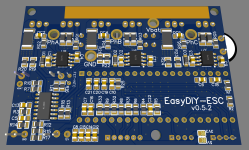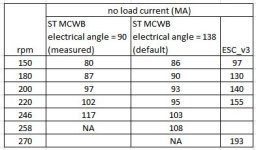Hi Everybody.
I just made a pull request for v0.5.2.
many minor improvements - but overall electrically almost identical to the v0.5. Software will need tiny changes though
Here's the "change log"
### Schematic
* changed voltage sense resistors to 10x lower value (basic jlcpcb resistors -> cheaper)
* removed pin 20 from GND (for blackpill compatibility)
* removed thermal reliefs
* replaced some parts with more cost-effective equivalents (basic parts jlcpcb)
* changed diodes to a bigger more rugged version (more inline with the philosophy of this controller)
* changed voltage sense divider so max read voltage is 100V (20s compatibility)
* added circuitry for a ntc temp sensor for mosfets.
* changed the electrolytic caps from the 12V and 5V rails to MLCC (still more capacitance than manufacturer recommends)
* swapped ntc pins: MOSFET Temp -> A0, and Motor Temp -> A1 (for compatibility with EBiCS v2)
* changed pinout of HALL JST connector - now you can use, additionally to a 6 pin connector for motors with temp NTC sensor, a 5pin connector on pins 1-5 and it will directly be compatible with the cable of a motor without temp sensor (M365 would be a popular example)
### PCB Design
* added 3 through hole pads for vbat, 12v, and gnd for easy connection with wires of any dc-dc module for more flexibility
* moved JST connectors away from bluepill for better fitting (increased board width by 1mm)
* removed soldermask from switch nodes, so conductivity can be improved (solder, etc)
* many minor layout changes
I think I am done with this version (0.5.*) - meaning other than fixes I will not change anything.
Hope to do some more substantial improvements though for v0.6 - but that's far in the uncertain future.
Here some pics



Br,
)

















